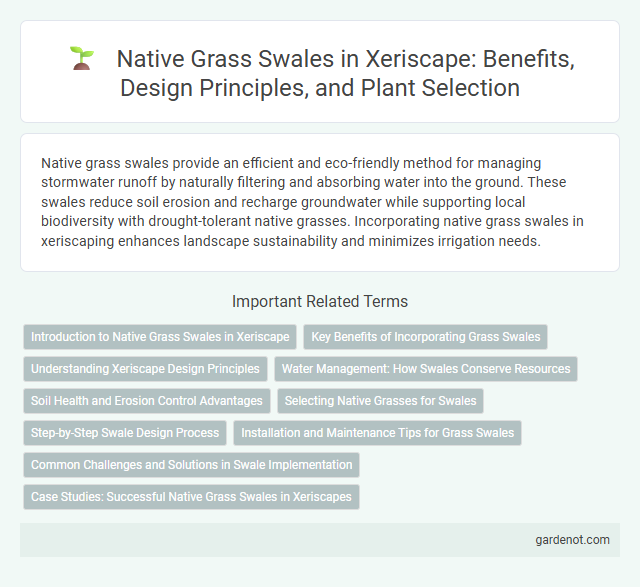Native grass swales provide an efficient and eco-friendly method for managing stormwater runoff by naturally filtering and absorbing water into the ground. These swales reduce soil erosion and recharge groundwater while supporting local biodiversity with drought-tolerant native grasses. Incorporating native grass swales in xeriscaping enhances landscape sustainability and minimizes irrigation needs.
Introduction to Native Grass Swales in Xeriscape
Native grass swales are essential elements in xeriscaping, designed to capture and infiltrate stormwater efficiently while reducing soil erosion. These linear landscape features use deep-rooted native grasses like buffalo grass, blue grama, and switchgrass to enhance water absorption and improve soil health. Integrating native grass swales into xeriscape designs promotes sustainable water management and supports local biodiversity.
Key Benefits of Incorporating Grass Swales
Native grass swales enhance xeriscape landscaping by efficiently managing stormwater runoff and reducing soil erosion, promoting groundwater recharge through natural infiltration. These swales support local biodiversity, providing habitat for pollinators and beneficial insects while requiring minimal irrigation and maintenance compared to conventional lawns. Integrating native grasses in swales improves landscape resilience, conserving water resources and lowering long-term landscaping costs.
Understanding Xeriscape Design Principles
Native grass swales are a key element in Xeriscape design, promoting efficient water absorption and reducing runoff in drought-prone landscapes. These swales use deep-rooted native grasses to enhance soil infiltration, minimizing the need for irrigation and supporting sustainable water management. Incorporating native grass swales aligns with Xeriscape principles by conserving water, improving soil health, and creating resilient, low-maintenance landscapes.
Water Management: How Swales Conserve Resources
Native grass swales play a crucial role in xeriscape water management by capturing and channeling stormwater, reducing runoff and promoting groundwater recharge. The deep root systems of native grasses enhance soil infiltration, efficiently conserving water and minimizing erosion. These swales act as natural biofilters, improving water quality while supporting sustainable landscaping practices.
Soil Health and Erosion Control Advantages
Native grass swales improve soil health by promoting deep root systems that enhance soil structure and increase microbial activity, leading to better water infiltration and nutrient cycling. These swales effectively control erosion by stabilizing slopes and reducing surface runoff velocity, minimizing soil displacement during heavy rain events. Their adaptive traits allow them to thrive in local environments, further sustaining soil integrity and preventing degradation.
Selecting Native Grasses for Swales
Selecting native grasses for swales involves choosing species such as Blue Grama, Little Bluestem, and Switchgrass, which provide erosion control and efficient water filtration. These grasses thrive in local climate conditions, requiring minimal irrigation while supporting biodiversity and soil health. Proper selection enhances swale functionality by promoting infiltration and reducing stormwater runoff effectively.
Step-by-Step Swale Design Process
Designing a native grass swale begins with site analysis to determine topography, soil type, and water flow patterns. Next, contour lines are marked to establish swale alignment, followed by excavation to create a shallow, broad channel with gently sloping sides. Finally, native grasses are planted to stabilize soil, enhance infiltration, and support water retention in xeriscape landscapes.
Installation and Maintenance Tips for Grass Swales
Installing native grass swales involves selecting drought-tolerant grasses such as blue grama, buffalo grass, or switchgrass, and preparing a graded swale to direct runoff efficiently. To maintain grass swales, regularly monitor soil moisture levels, control invasive weeds, and mow sparingly to promote deep root growth and enhance water infiltration. Proper installation and ongoing maintenance reduce erosion, improve stormwater management, and support sustainable xeriscape landscapes.
Common Challenges and Solutions in Swale Implementation
Common challenges in implementing native grass swales include soil compaction, improper grading, and invasive species encroachment, which can hinder water absorption and plant growth. Solutions involve thorough soil preparation with decompaction techniques, precise contouring to ensure effective water flow, and regular maintenance including invasive species removal and reseeding with native grasses. Incorporating drought-tolerant species adapted to local climate enhances the swale's resilience and overall xeriscape functionality.
Case Studies: Successful Native Grass Swales in Xeriscapes
Case studies of native grass swales in xeriscapes demonstrate significant water retention and soil erosion control, particularly in arid regions like the southwestern United States. Projects in Arizona and New Mexico showcase swales planted with native grasses such as buffalo grass (Bouteloua dactyloides) and blue grama (Bouteloua gracilis), which thrive with minimal irrigation while enhancing stormwater infiltration. These successful implementations highlight the benefits of native grass swales in sustainable landscaping, reducing water usage by up to 50% compared to traditional lawns.
Native grass swale Infographic

 gardenot.com
gardenot.com